
How James Hitchmough used his Sheffield garden to trial South African summer perennials
From our archives: Professor James Hitchmough’s Sheffield garden is a test bed for his scholarly work and a masterclass in planting combinations. Words Caroline Beck, photographs Richard Bloom
Professor James Hitchmough is a hard man to get hold of. Apologetic emails from South Africa, China, the Orkney Islands or Kyrgyzstan explained he was photographing plants in high-altitude meadows. When I finally meet him, Stan his dog upstages him, scattering pots of exotic cuttings before barging into the borders after a cat. None of this fazes the professor. “My tolerance for disorder,” he explains, “is very high.”
Disorder is a word he uses often. As Professor of Horticultural Ecology in the Department of Landscape Architecture at Sheffield University, he’s spent 20 years probing how much ‘naturalism’ (for this read ‘chaos’) people can tolerate. Scrutinising his environment is second-nature to him. He grew up in a pit village in Northumberland surrounded by spoil heaps. “I asked myself, why is this place so bloody awful and what would make it better?” It’s a question he’s spent a lifetime answering.
What Richly planted small garden.
Where Sheffield, South Yorkshire.
Size Approximately 400 square metres.
Soil Loam, but with 100ml of fine gravel on the top soil as an establishment mulch as many of the plants need good sharp drainage.
Climate Temperate, with average temperatures varying between -3ºC in winter to 25ºC in the summer.
Hardiness rating USDA 8.
His own back garden behind his terraced house on one of Sheffield’s vertiginous hills is his outdoor laboratory. It was derelict when he bought it, meaning waist-high weeds needed to be cleared and remaining trees pruned to open up the shade canopy, and leave the remaining two-thirds open. The stylised meadow he has created unfolds from late winter onwards when bulbs and a low understory of woodland plants, such as primulas and ranunculus, reduces the area of bare soil that weeds would otherwise swiftly colonise, with taller summer plants emerging as the spring layer dies back. “Here I can examine how plants perform and use volumes of space as they grow, and from a design point of view it’s vital to be able to conceptualise this,” he says.
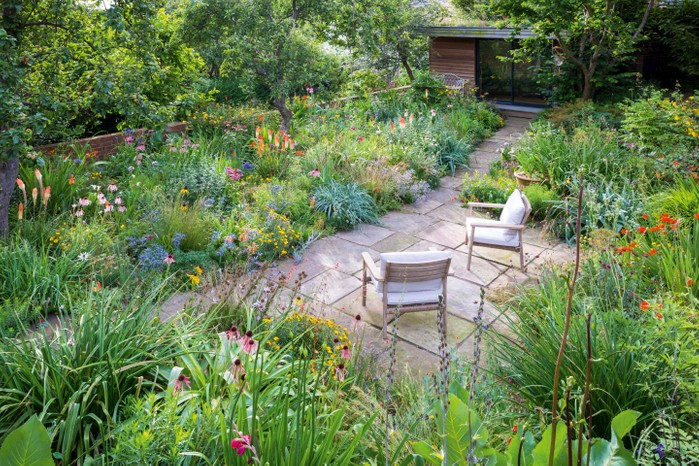
The plants in James Hitchmough's small city garden are like stamps in his passport, numerous and exotic. For the past decade, however, South African species, such as the Kniphofia ‘Jane Henry’ and Gladiolus ‘Ruby’ seen above, have been his abiding interest. Most South African species familiar to gardeners, come from eastern summer rainfall areas, but James has been researching plants from western winter rainfall areas, such as the Hex River and the Komsberg, which are far less common. “It gets down to minus eight, so many of these species, such as Bulbinella latifolia and Watsonia marlothii, grow really well in the UK,” he says.

Summer plants, such as Echinacea pallida and Kniphofia albomontana, are selected mostly to have leafless stems so the borders have a certain wildness rather than a neat en bloc structure. Here they combine with Eryngium bourgatii ‘Picos Blue’, Echinops ritro, Echinacea purpurea ‘Prairie Splendor’, Agapanthus campanulatus subsp. patens, Kniphofia ‘Jane Henry’, Crocosmia masoniorum and Hemerocallis ‘Lemon Bells’, combine to bring a ‘supercharged nature’ aspect to his richly planted borders. “Initially there wasn’t a warm reception to the idea of naturalistic vegetation,” says James, "but now it’s become much more normalised, and things like the Olympic Park [where James and his Sheffield University colleague Professor Nigel Dunnett acted as planting design consultants] played a major part in that. It’s having your cake and eating it, but what’s wrong with that?”
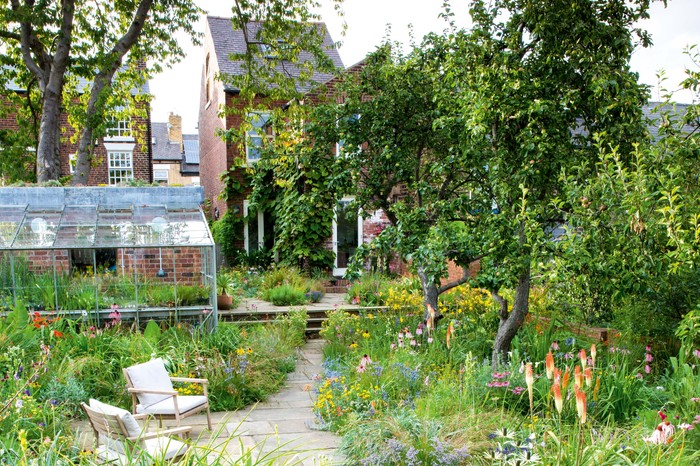
Five lessons for a city space
- Don’t discount exotic species. Many South African plants are very happy in urban Sheffield.
- A good ground layer of plants, out of which other, taller things can emerge, will keep the garden looking good in the early months, so plant large numbers of shade-tolerant understorey plants, such as primulas and ranunculus.
- Trying to have flowers from January to November means that you have to open the vegetation up more than if you just want a garden from April to September. It’s more work, but you’re rewarded with greater visual interest.
- Dogs and gardens can be tricky. This is the first garden James has had with a dog – one that occasionally wants to dig a big hole.
- Don’t be in a big rush to discard plants that don’t seem to be performing. Give them another year as it makes a big difference.
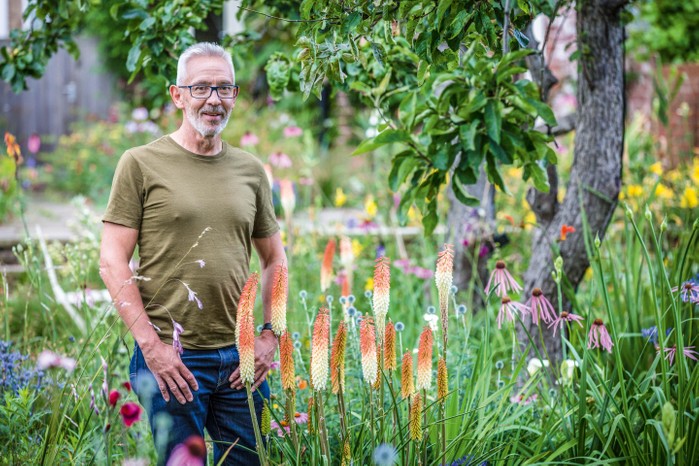
During his time as Professor of Horticultural Ecology at theUniversity of Sheffield, James Hitchmough used his Sheffield garden to trial new plants.
James’s favourite summer plants
Hemerocallis ‘Lemon Bells’
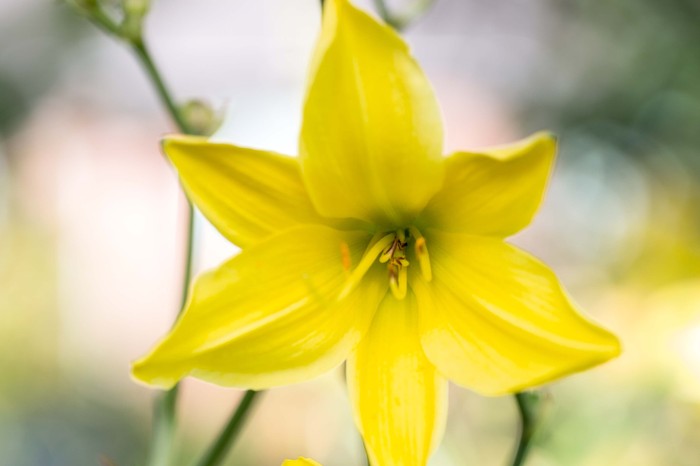
Multi-headed, lemon-coloured, lily-like flowers with bronzed backs blooming in midsummer, which hold up well above foliage. 1.2m. RHS H6, USDA 4a-9b†.
Galtonia candicans

The summer hyacinth, a native of South Africa, sends up spires of pure-white flowers over strap-like foliage. 1.2m. AGM*. RHS H4, USDA 6a-10b.
Berkheya purpurea

A South African species that likes a sheltered, well-drained spot in full sun. Resembles a daisy crossed with a sunflower. 60cm. RHS H4, USDA 6a-11.
Crocosmia masoniorum

Likes moist but well-drained soil and produces tall, arching spikes of fiery orange flowers. Good for cutting. 70cm. AGM. RHS H4, USDA 6a-9b.
Themeda triandra

A blue-green, tufted, tussock-forming grass that turns rust red as it ages. Although it’s tough, it needs well-drained soil. 1.5m.
Tulbaghia violacea ‘Peppermint Garlic’

Can be tender in cold areas so best overwintered in a greenhouse. Otherwise, trouble free. Flowers best if divided regularly. 50cm. USDA 7a-10b.
Echinacea paradoxa

A corn-yellow coneflower, with drooping petals around a velvet-brown centre. 1m. RHS H5, USDA 3a-8b.
Gladiolus ‘Ruby’

A glamorous, deep-red, funnel-shaped flower, which emerges from a corm. Needs full sun to flower reliably. 75cm. RHS H4, USDA 8a-10b.
*Holds an Award of Garden Merit from the Royal Horticultural Society.†Hardiness ratings given where available.
You can find more information on plant hardiness ratings here.
Note: We featured this garden in our magazine in 2017, James has since moved house, which we featured in Gardens Illustrated magazine. Subscribe here.

Niwaki bundle worth £57 when you subscribe
Subscribe to Gardens Illustrated magazine and claim your Niwaki bundle worth £57
*UK only
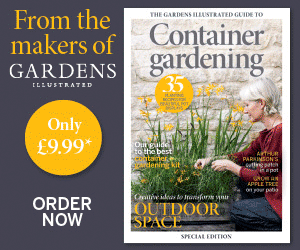
Container Gardening Special Edition
The Gardens Illustrated Guide to Container Gardening.
In this special edition, discover colourful flower combinations and seasonal planting schemes for pots designed by leading plantspeople, and essential know-how for container gardening success. Just £9.99 inc UK p&pBy entering your details, you are agreeing to our terms and conditions and privacy policy. You can unsubscribe at any time.
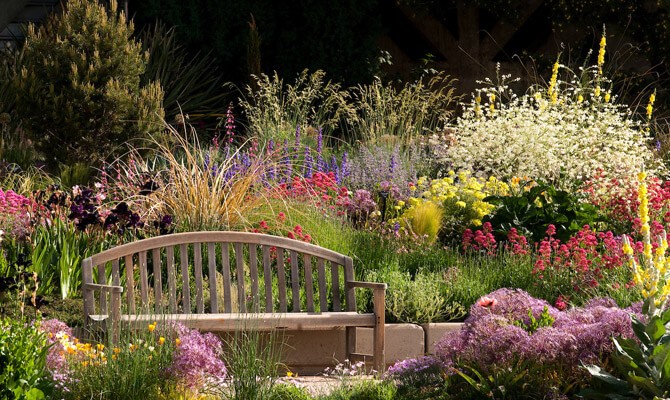
Gardens of the Globe
From botanical wonders in Australia to tranquil havens closer to home in Ireland, let this guide help you to discover some of the most glorious gardens around the world
By entering your details, you are agreeing to our terms and conditions and privacy policy. You can unsubscribe at any time.




